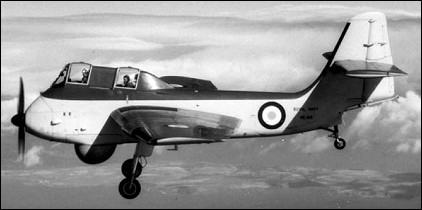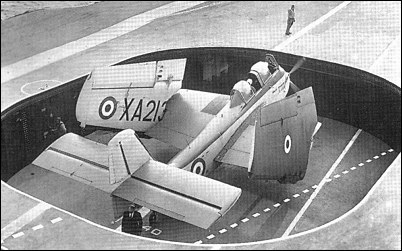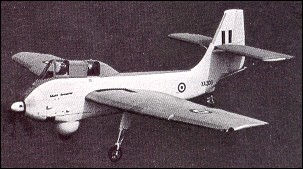|
| The ungainly Seamew was conceived as a cheap, rugged anti-submarine
aircraft able to operate from small carriers used by the UK and some other
allied nations. To this end it was built with a fixed landing gear and a strong
structure. Despite this, the prototype was badly damaged on its first landing,
although it was repaired in time for the Farnborough Air Show.
In handling terms the Seamew was described as having some 'vicious
tendencies'. It was capable of aerobatics, but the chief test pilot seemed to be the
only one able to wring the full manoeuvrability out of the Seamew - until he
stalled the prototype Mk.2 during a display and was killed. Production began for
RAF Coastal Command and the Royal Navy, but the RAF order was cancelled
in 1956 and the Navy's was a victim of the defence cuts of the following year. FACTS AND FIGURES © The Mk 2 was a version for Coastal
Command with larger wheels and
manual wing folding. It was cancelled
after rwo were completed. © The fixed undercarriage legs
could be jettisoned in the
event of a ditching at sea.
 | A three-view drawing (800 x 456) |
© The need to house a large search
radar under the belly led to the
adoption of a tailwheel undercarriage
layout, which by the mid-1950s was
regarded as somewhat old-fashioned
for carrier aircraft.
| MODEL | S.B.6 |
| CREW | 2 |
| ENGINE | 1 x 1780hp Armstrong Siddeley Mamba turboprop |
| WEIGHTS |
| Take-off weight | 6804 kg | 15000 lb |
| DIMENSIONS |
| Wingspan | 16.75 m | 55 ft 11 in |
| Length | 12.50 m | 41 ft 0 in |
| PERFORMANCE |
| Max. speed | 378 km/h | 235 mph |
| Phil Runciman, e-mail, 18.11.2010 10:14 Hugo said, "It dropped out of a slow roll - not the sort of error a highly experienced test pilot would have made." Having seen this and similar manoeuvres repeated over Belfast Lough on many occasions I would conclude that another factor intruded. The crash investigation did not explore that idea. It came up with the "pilot error" tag. Brooky had a higher opinion than Hugo's of his abilities, as did Arthur Pearcy. My father joined Short because Brooke-Smith was in hospital after crashing the Sherpa. He survived his crash but my father did not. Nowadays the simulators are often harder to fly than the actual aircraft. Times change. reply | | Hugo, 03.11.2010 11:53 A couple of points: It was not the chief test pilot who was responsible for, had the most hours on and could manage the Seamew best. Shorts' CTP at the time was Brooke-Smith, the Seamew's test pilot was W.J.Runciman. Also the aircraft did not stall and crash. It dropped out of a slow roll - not the sort of error a highly experience test pilot would have made. reply | | JACK CAIRNS, e-mail, 18.04.2009 05:01 HI BUD - YES , I ALSO WAS THERE AT THE CRASH - VERY SAD - I LATER SERVED APPRENTISHIP AT SHORTS - MANY FED. GOVT FUNDED AIRCRAFT BUILT , NO AIRLINE OR MILITARY ORDERS - USUAL STORY WITH GOVT DEPT PROJECTS - UNIONS DID NOT HELP - J.C. reply | | John Bell, e-mail, 03.03.2009 00:04 I saw the Seamew during many of the test flights as a small boy. I also was there when it crashed at the Sydenham Air display. One interesting fact - I watched it climb one day to about 3,000ft and then stop the propellor and it then dived downwards. This happened several times and I gathered this was to try and improve the diving speed without the drag of the propellor!! reply | |
| | Robin Tuff, e-mail, 21.02.2007 12:15 Splendid site.
The Seamew never entered service. As a cocept it was alrerady out of date reply |
|
Do you have any comments?
|
| 
COMPANY
PROFILE
All the World's Rotorcraft
|









